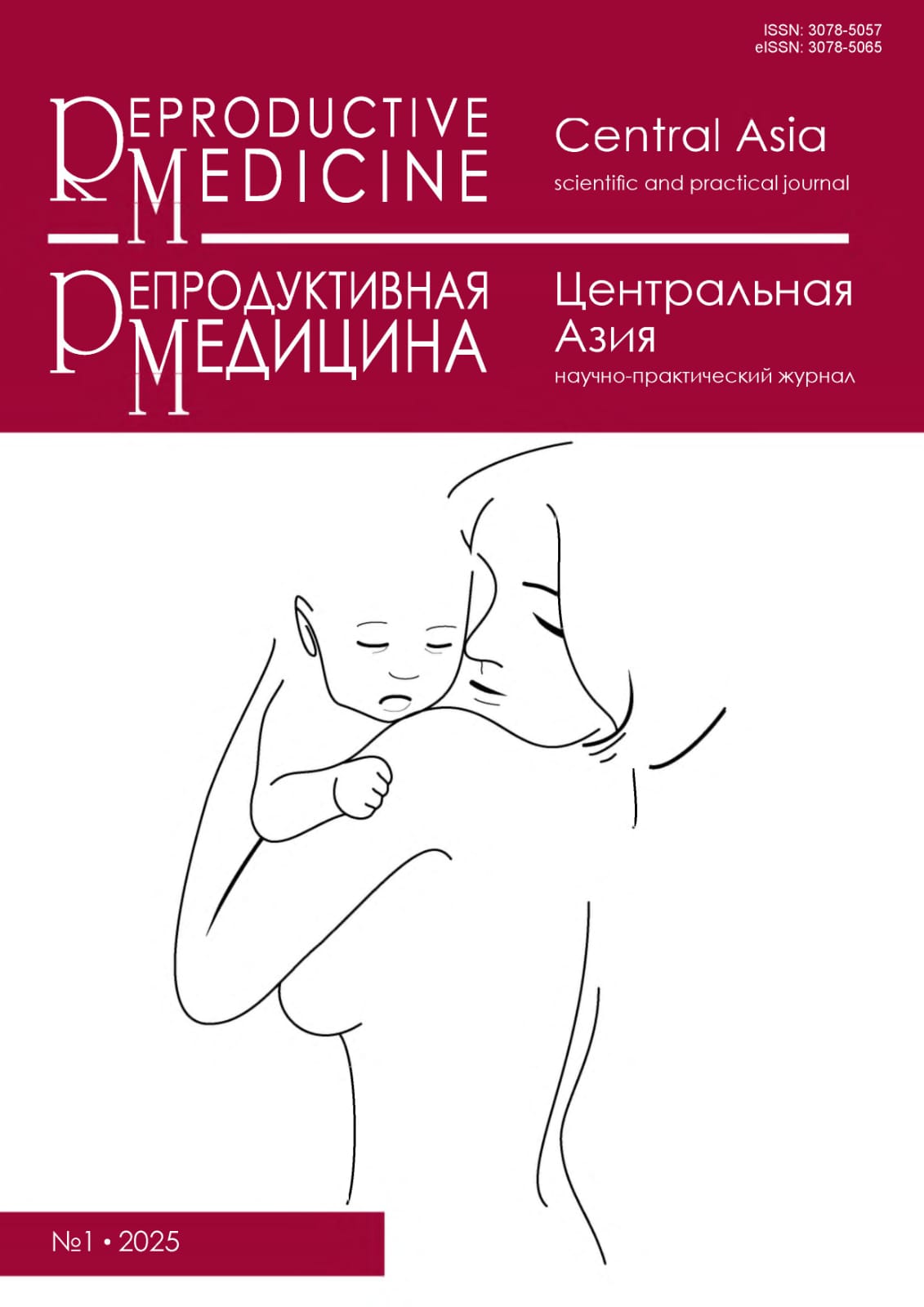Minimally invasive technologies in stabilizing the respiratory status of preterm infants: A literature review
DOI:
https://doi.org/10.37800/RM.1.2025.459Keywords:
preterm infants, respiratory failure, minimally invasive technologies, LISA, lung ultrasound, cardiac ultrasound, inhaled nitric oxideAbstract
Relevance: The high incidence of premature infants remains a serious public health problem, as they require specialized care. Stabilizing the
condition in the first minutes of life is critical for survival and health.
This literature review focuses on the stabilization of the respiratory status of premature infants using minimally invasive technologies. It has
been established that such methods as heated and humidified high-flow nasal cannula, LISA (less invasive surfactant administration), lung
ultrasound, POCUS (Point-of-Care Ultrasound), cardiac ultrasound, electrocardiography, and nitric oxide inhalation help reduce respiratory
complications and improve long-term outcomes.
The study aimed to analyze the literature and comment on current approaches to stabilization of the respiratory status using minimally
invasive technologies in premature infants soon after birth, as well as to identify insufficiently studied aspects of their use in neonatal practice.
Materials and Methods: A review of scientific sources from PubMed, Scopus, Web of Science, and eLibrary for 2014-2024 was conducted.
Studies evaluating the effectiveness of minimally invasive respiratory support methods were selected.
Results: The analysis confirmed that minimally invasive technologies contribute to prolonged oxygenation, decreased bronchopulmonary
dysplasia and intraventricular hemorrhage incidence, and accurate diagnosis of cardiorespiratory disorders.
Conclusion: Using minimally invasive technologies reduces the need for invasive interventions, increases survival, and improves long-term
outcomes in premature infants, which requires an individualized approach.
References
World Health Organization. Preterm birth. 2020 [cited 2025 Mar 13]. Available from:
https://www.who.int/news-room/fact-sheets/detail/preterm-birth
Stoll BJ, Nellie I Hansen, Edward F Bell, Seetha Shankaran, Abbot R Laptook, Michele C Walsh, Ellen C Hale, Nancy S Newman, Kurt Schibler, Waldemar A CarloShampa Saha, Abhik Das, Rosemary D Higgins; Eunice Kennedy Shriver National Institute of Child Health and Human Development Neonatal Research Network. Neonatal Outcomes of Extremely Preterm Infants from the NICHD Neonatal Research Network. Pediatrics. 2015;135(1):1-9.
https://doi.org/10.1542/peds.2009-2959
Lemyre B, Laughon M, Bose C, Davis PG. Early nasal intermittent positive pressure ventilation (NIPPV) versus early nasal continuous positive airway pressure (NCPAP) for preterm infants. Cochrane Database Syst Rev. 2023; CD005384.
https://doi.org/10.1002/14651858.CD005384.pub2
Berbenetz N, Wang Y, Brown J, Godfrey C, Ahmad M, Vital FMR, Lambiase P, Banerjee A, Bakhai A, Chong M. Non-invasive ventilation for preterm infants. Cochrane Database Syst Rev. 2016;2016(3).
https://doi.org/10.1002/14651858.CD005351.pub4
Kurepa D, Perveen S, Lipener Y, Kakkilaya V. The use of less invasive surfactant administration (LISA) in the United States with review of the literature. J Perinatol. 2019;39(7):426-432.
https://www.nature.com/articles/s41372-018-0302-9
Gregorio-Hernández R, Pérez-Pérez A, Alonso-Ojembarrena A, Arriaga-Redondo M, Ramos-Navarro C, Sánchez-Luna M. Neonatal pneumothoraces with atypical location: the role of lung ultrasound. Eur J Pediatr. 2022;181:1751-1756.
https://link.springer.com/article/10.1007/s00431-021-04329-z
Barrington KJ, Finer N, Pennaforte T, Altit G. Nitric oxide for respiratory failure in infants born at or near term. Cochrane Database Syst Rev. 2017;2017(1):CD000399.
https://doi.org/10.1002/14651858.CD000399.pub3
Kanevska U, Guczynska E. The impact of surfactant administration techniques (LISA vs INSURE) on the outcomes of treatment for respiratory distress syndrome in preterm infants. Dev Period Med. 2019;23(3):163-171.
https://doi.org/10.34763/devperiodmed.20192303.163171
Mansouri S, Servatyari K, Rahmani K, Sheikhahmadi S, Hemmatpour S, Eskandarifar A, Rahimzadeh M. Comparison of Two Surfactant Administration Techniques (LISA vs INSURE) in Preterm Infants with Respiratory Distress Syndrome: A Retrospective Cohort Study. J Neonatal Perinat Med. 2024;17(2):123-131.
https://doi.org/10.3233/npm-230194
Mishra A, Joshi A, Londhe A, Deshmukh L. Comparison of Two Surfactant Administration Techniques (LISA vs InSurE) in Preterm Infants with Respiratory Distress Syndrome: A Randomized Controlled Trial. Pediatr Pulmonol. 2023;58(3):738-745.
https://doi.org/10.1002/ppul.26246
Zamal A, Sk MH, Saha B, Hazra A. Comparison of efficacy between beractant and poractant alfa in respiratory distress syndrome among preterm infants (28–33+6 weeks gestational age) using the less invasive surfactant administration (LISA) technique: A randomized controlled trial. J Perinatol. 2024 Apr 12. Epub ahead of print.
https://doi.org/10.1038/s41372-024-01962-y
Dini G, Santini MG, Celi F. Less Invasive Surfactant Administration (LISA) Versus INSURE Method in Preterm Infants: a Retrospective Study. Med Arch. 2024;78(2):112-116.
https://doi.org/10.5455/medarh.2024.78.112-116
Buyuktiryaki M, Alarcon-Martinez T, Simsek GK, Canpolat FE, Tayman C, Oguz SS, Kutman HGK. Five-year single center experience on surfactant treatment in preterm infants with respiratory distress syndrome: LISA vs INSURE. Early Hum Dev. 2019;135:32-36.
https://doi.org/10.1016/j.earlhumdev.2019.06.004
Oktem A, Yigit S, Oğuz B, Celik T, Haliloğlu M, Yurdakok M. Accuracy of lung ultrasonography in the diagnosis of respiratory distress syndrome in newborns. J Matern Fetal Neonatal Med. 2021;34(2):281-286.
https://doi.org/10.1080/14767058.2019.1605350
Liu J, Cao H, Liu Y. Lung ultrasonography for the diagnosis of neonatal respiratory distress syndrome: a pilot study. Zhonghua Er Ke Za Zhi. 2013;51(3):205-210.
https://pubmed.ncbi.nlm.nih.gov/23751583/
Jing Liu, Ying Liu, Hua-wei Wang, Jing-ya Li, Tao Han, Jing Liang, Chang-shuan Yang, Meng Xing, Zhi-chun Feng. Lung ultrasound for diagnosis of neonatal atelectasis. Zhonghua Er Ke Za Zhi. 2013 Sep;51(9):644–648. [Article in Chinese]. PMID: 24330981.
https://pubmed.ncbi.nlm.nih.gov/24330981/
Sefic Pasic I, Riera Soler L, Vazquez Mendez E, Castillo Salinas F. Comparison between lung ultrasonography and chest X-ray in the evaluation of neonatal respiratory distress syndrome. J Ultrasound. 2023;26(2):435-448.
https://doi.org/10.1007/s40477-022-00728-6
Copetti R, Cattarossi L, Macagno F, Violino M, Furlan R. Lung ultrasound in respiratory distress syndrome: a useful tool for early diagnosis. Neonatology. 2008;94(1):52-59.
https://doi.org/10.1159/000113059
Alonso-Ojembarrena A, Gregorio-Hernández R, Raimondi F. Neonatal point-of-care lung ultrasound: what should be known and done out of the NICU? Eur J Pediatr. 2024;183(4):1555-1565.
https://doi.org/10.1007/s00431-023-05375-5
Nemes AF, Toma AI, Dima V, Serboiu SC, Necula AI, Stoiciu R, Ulmeanu AI, Marinescu A, Ulmeanu C. Use of Lung Ultrasound in Reducing Radiation Exposure in Neonates with Respiratory Distress: A Quality Management Project. Medicina (Kaunas).
;60(2):308.
https://doi.org/10.3390/medicina60020308
Myers F, Dasani R, Tong J, Vallandingham-Lee S, Manipon C, Dahlen A, De Luca D, Singh Y, Davis AS, Chock VY, Bhombal S. Point of-care lung ultrasound for continuous positive airway pressure discontinuation in preterm infants. J Perinatol. 2025;45(1):68-72.
https://doi.org/10.1038/s41372-024-02157-1
Amer R, Rozovsky K, Elsayed Y, Bunge M, Chiu A. The utility of point-of-care ultrasound protocol to confirm central venous catheter placement in the preterm infant. Eur J Pediatr. 2023;182(11):5079-5085.
https://doi.org/10.1007/s00431-023-05172-0
Fernández LR, Hernández RG, Guerediaga IS, Gato JM, Fanjul JR, Bilbao VA, Quintela PA, Ojembarrena AA; Pulmonary Ultrasound Section of the Neonatal Ultrasound Working Group of the Spanish Society of Neonatology. Usefulness of lung ultrasound in the diagnosis and follow-up of respiratory diseases in neonates. An Pediatr (Engl Ed). 2022;96(3):190-198.
https://doi.org/10.1016/j.anpedi.2022.01.002
Kotidis C, Wertheim D, Weindling M, Rabe H, Turner MA. Assessing patent ductus arteriosus in preterm infants from standard neonatal intensive care monitoring. Eur J Pediatr. 2022;181(3):1117-1124.
https://doi.org/10.1007/s00431-021-04311-9
Isayama T, Kusuda S, Reichman B, Lee SK, Lehtonen L, Norman M, Adams M, Bassler D, Helenius K, Hakansson S, Yang J, Jain A, Shah PS; International Network for Evaluating Outcomes of Neonates (iNeo) Investigators. Neonatal Intensive Care Unit-Level Patent Ductus Arteriosus Treatment Rates and Outcomes in Infants Born Extremely Preterm. J Pediatr. 2020;220:34-39.e5.
https://doi.org/10.1016/j.jpeds.2020.01.069
Sahni R, Ameer X, Ohira-Kist K, Wung J-T. Non-invasive inhaled nitric oxide in the treatment of hypoxemic respiratory failure in term and preterm infants. J Perinatol. 2017;37(1):54-60.
https://doi.org/10.1038/jp.2016.164
Barrington KJ, Finer N. Inhaled nitric oxide for respiratory failure in preterm infants. Cochrane Database Syst Rev.
;12:CD000509.
https://doi.org/10.1002/14651858.CD000509.pub4
DiBlasi RM, Dupras D, Kearney C, Costa E Jr, Griebel JL. Nitric oxide delivery by neonatal noninvasive respiratory support devices. Respir Care. 2015;60(2):219-230.
Downloads
Published
How to Cite
Issue
Section
License
Copyright (c) 2025 The rights to a manuscript accepted for publication are transferred to the Journal Publisher. When reprinting all or part of the material, the author must refer to the primary publication in this journal.

This work is licensed under a Creative Commons Attribution-NonCommercial-NoDerivatives 4.0 International License.
The articles published in this Journal are licensed under the CC BY-NC-ND 4.0 (Creative Commons Attribution – Non-Commercial – No Derivatives 4.0 International) license, which provides for their non-commercial use only. Under this license, users have the right to copy and distribute the material in copyright but are not permitted to modify or use it for commercial purposes. Full details on the licensing are available at https://creativecommons.org/licenses/by-nc-nd/4.0/.




